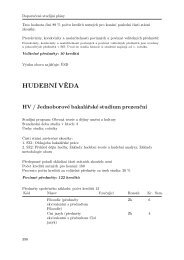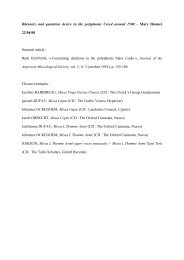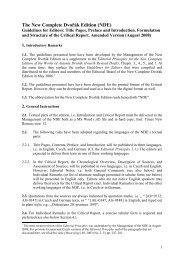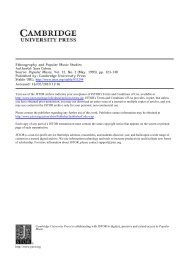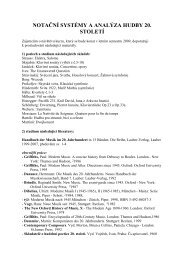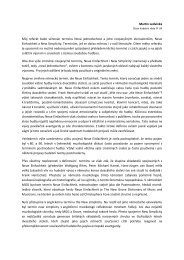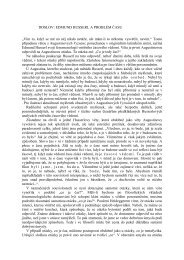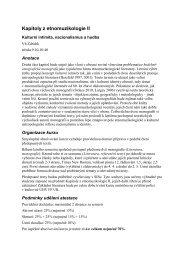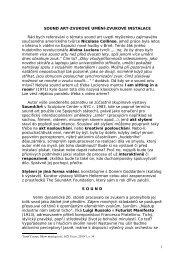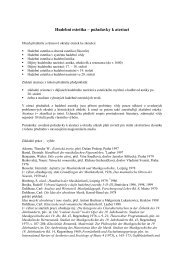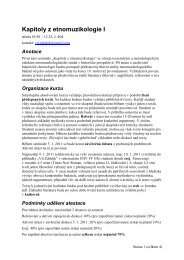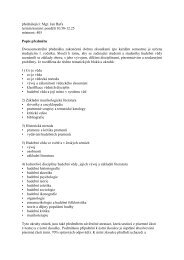The New Complete Dvořák Edition (NDE)
The New Complete Dvořák Edition (NDE)
The New Complete Dvořák Edition (NDE)
You also want an ePaper? Increase the reach of your titles
YUMPU automatically turns print PDFs into web optimized ePapers that Google loves.
<strong>The</strong> <strong>New</strong> <strong>Complete</strong> <strong>Dvořák</strong> <strong>Edition</strong> (<strong>NDE</strong>)<br />
Guidelines for Editors: Formation of the Main Musical Text<br />
Supplements to the Amended Version of August 2008<br />
Introductory Remark<br />
<strong>The</strong> guidelines presented here have been developed by the Management of the <strong>New</strong> <strong>Complete</strong><br />
<strong>Dvořák</strong> <strong>Edition</strong> (<strong>NDE</strong>) as a supplement to the Editorial Principles for the <strong>New</strong> <strong>Complete</strong><br />
<strong>Edition</strong> of the Works of Antonín <strong>Dvořák</strong> (Fourth Revised Draft), Chapts. 5–6.<br />
Formation of the Main Musical Text<br />
General Comment<br />
“<strong>The</strong> engraver’s (notesetter’s) copy for the main musical text of the <strong>New</strong> <strong>Complete</strong> <strong>Edition</strong> of the Works of<br />
Antonín <strong>Dvořák</strong> must be prepared with the greatest possible degree of exactitude. <strong>The</strong> musical notation in the<br />
edition is guided by the rules for musical notation customary today; see the summary by Albert C. Vinci (in:<br />
Fundamentals of Traditional Musical Notation, <strong>The</strong> Kent State University Press 1985). At the same time, it must<br />
remain as faithful as possible to the available sources and also preserve the peculiarities of <strong>Dvořák</strong>’s manner of<br />
notation”. (Editorial Principles for the <strong>NDE</strong>, Chapt. 5)<br />
In other words, the engraver’s (notesetter’s) copy prepared by the editor(s) should record and<br />
check all parameters and all details of the final critical musical text. <strong>The</strong> editor may use<br />
conventional proof-correction marks, other graphical symbols, or short verbal instructions for<br />
indicating his or her editorial interventions and write them down in red ballpoint pen or<br />
fineliner. (See Appendix, pp. 6–9.) <strong>The</strong> notesetters of the music engraving studio Ritornel<br />
Ltd. (Ostrava, CZ, www.ritornel.com ) are expected to produce a true diplomatic transcription<br />
of the engraver’s copy, except for cases that are described and specified below in par 2.<br />
1. Additions, Unifications, and Corrections<br />
[…]<br />
2. Marked and Unmarked Additions and Changes<br />
“As a rule, additions and corrections by the editors are indicated as such by the use of square brackets or dotted<br />
lines; see above. In certain cases, however, they may be carried out without such indication, primarily in the case<br />
of correcting the notational and engraving peculiarities of the time or omissions. <strong>The</strong> prerequisite is that the<br />
source situation in these cases is clear and is explained in summary in the Critical Report.” (Editorial Principles<br />
for the <strong>NDE</strong>, 5.2.)<br />
<strong>The</strong> notesetters are expected to execute the following additions to and changes in the main<br />
musical text that are not indicated as such in the engraver’s copy:<br />
→ Changes in the number of staves in a system; i.e. eliminating or hiding empty staves for<br />
resting instruments and instrumental sections<br />
→ Supplying missing full-measure rest marks<br />
→ Eliminating superfluous rests in pairs of instruments notated on a single staff; i.e. in all<br />
cases where only one member of an instrumental pair is to play for a number of measures<br />
→ Supplying slurs between grace notes and main notes<br />
→ Supplying tie marks in held chords<br />
1
→ Supplying missing symbols and numbers for triplets, sextuplets, and other irregular<br />
rhythmic groups<br />
→ Eliminating slurs over numbers for triplets, sextuples, and other irregular rhythmic groups<br />
→ Writing out repetitions of individual measures and/or figures of several tones indicated<br />
only by abbreviations ( ۟ / . ), and passages marked colla parte<br />
→ Eliminating dots following tempo markings and other verbal instructions in the main<br />
musical text (except for abbreviations)<br />
→ Adjusting the older manner of writing beams (for two or more eighth-, sixteenth-, or other<br />
small note values) to today’s norm.<br />
If the editor wishes to preserve the original manner of notation in some of the mentioned<br />
instances (e.g. keeping rests in pairs of instruments notated on a single staff, keeping slurs<br />
over numbers for triplets or sextuplets, keeping abbreviations for repetitions or older manner<br />
of writing beams, a.o.), he or she is obliged to indicate this explicitly e.g. by verbal<br />
instructions: “preserve the original notation”, “do not make changes”, a.o.<br />
3. Title of Work, Opus Number, Burghauser Number, and Dedication<br />
“<strong>The</strong> titles of works are given in three languages by using modern spelling and in the order English – Czech –<br />
German. […] After the title of the work come the opus number (if one exists) and the Burghauser number.<br />
Below this information is the dedication (if there is one), again in three languages in modern spelling.” […]<br />
(Editorial Principles for the <strong>NDE</strong>, 5.3.)<br />
Titles, opus numbers, Burghauser numbers, dedications, and contents (i.e. ordering of<br />
individual movements or numbers) are given on recto pages, and the list of roles, and vocal<br />
parts, and instrumentation on the next verso page(s) preceeding the main musical text of the<br />
volume(s) in question. <strong>The</strong> numbers for individual movements of symphonic or chamber<br />
works (inscribed in Roman numerals with dots: I., II., etc.) and other designations for parts of<br />
vocal-instrumental and stage works (e.g. Overture, Scene I., etc.) are given on the head of the<br />
first pages (or systems) of the respective main musical text.<br />
4. Arrangement of Score and Designation of Instruments<br />
“<strong>The</strong> score is arranged in the manner customary today, i.e. from the top downward woodwinds, brass,<br />
percussion, harp, piano (or harmonium or organ), and strings.<br />
Vocal parts and solo instrumental parts are placed immediately above the strings.<br />
Before the first staff system in each movement, which is given in complete form, the Italian names of the<br />
instruments and vocal parts are written out in modern spelling and in upright lettering. For transposing<br />
instruments the key is given in the English form in parentheses, e.g.<br />
Clarinetto I (Bb)<br />
<strong>The</strong> original ordering and designation of the parts is described in the Critical Report. In addition, the first page of<br />
the score is given as a facsimile if possible; see 3.4 above and 7.6 below. Starting with the second staff system in<br />
each movement the designation of instruments and vocal parts is repeated only in abbreviated form without<br />
dots”; see also 5.2. (Editorial Principles for the <strong>NDE</strong>, 5.4)<br />
<strong>The</strong> ordering of percussion instruments is as follows (from the top downward):<br />
Timpani<br />
Triangolo<br />
Batteria (Piatti + Gran Cassa, etc.)<br />
2
Remember: Unlike the previous (third) draft of the Editorial Principles for the <strong>NDE</strong>, the<br />
current (fourth) draft requires the preservation of the original method of notation for<br />
unpitched percussion instruments i.e. five-line staves with clefs.<br />
Designations of instruments and vocal parts and their abbreviations are as follows (see also<br />
Guidelines for Editors: Title Pages, Preface and Introduction … Amended Version of<br />
August 2008, Appendix 3):<br />
Flauto piccolo<br />
Flauto<br />
Oboe<br />
Corno inglese<br />
Clarinetto<br />
Clarinetto basso<br />
Clarinetto contrabbasso<br />
Fagotto<br />
Contraffagotto<br />
Corno<br />
Tromba<br />
Trombone<br />
Tuba<br />
Timpani<br />
Triangolo<br />
Piatti<br />
Tamburo piccolo<br />
Tamburetto<br />
Tamburino<br />
Gran Cassa<br />
Campana<br />
Campanello<br />
Tam-tam<br />
Arpa<br />
Pianoforte<br />
Armonio<br />
Organo<br />
Soprano<br />
Contralto<br />
Tenore<br />
Basso<br />
Violino I<br />
Violino II<br />
Viola<br />
Violoncello<br />
Contrabbasso<br />
Picc<br />
Fl<br />
Ob<br />
Cor ingl<br />
Cl<br />
Cl basso<br />
Cl cbasso<br />
Fg<br />
Cfg<br />
Cor<br />
Tr<br />
Trbn<br />
Tb<br />
Timp<br />
Trgl<br />
Pti<br />
Tamb picc<br />
Tambto<br />
Tamb<br />
Gr Cassa<br />
Camp<br />
Camplo<br />
Tam-tam<br />
Arpa<br />
Pfte<br />
Arm<br />
Org<br />
S<br />
A<br />
T<br />
B<br />
Vl I<br />
Vl II<br />
Va<br />
Vc<br />
Cb<br />
<strong>The</strong> following scoring terms are to be used in unabbreviated form and without dots (or<br />
colons):<br />
a 2 solo (sola) archi <strong>The</strong> names of characters in stage<br />
arco tutti legni works and oratorios e.g.: Toník,<br />
muta in Soli ottoni Lenka, Řeřicha, Armida, Ismen,<br />
sul tasto Coro fiatti Rinald, etc.<br />
sul G (D, A, etc.)<br />
3
[…]<br />
<strong>The</strong> following scoring terms are to be used in abbreviated and standardized form (with dots):<br />
marc. div. ad lib.<br />
stacc. con sord. ten.<br />
cresc. senza sord. unis.<br />
decresc. pizz. 4. (3., 2., 1.) corda<br />
dim.<br />
sul pont.<br />
5. Tempo and Metronome Markings, Orientation Letters, Numbering of Measures,<br />
Bar Lines<br />
“General metronome and tempo markings as well as orientation letters are invariably placed both<br />
above the top staff of the whole staff system and above the strings”. (Editorial Principles for the <strong>NDE</strong>, 5.5)<br />
In operas and other vocal works with orchestra and in concertos and other works for solo<br />
instrument and orchestra, the mentioned markings and symbols are to be placed above the<br />
vocal part(s) and above the solo instrumental part, too.<br />
<strong>The</strong> format for metronome markings is as follows:<br />
Allegro q = 132<br />
“Bars are numbered separately for each movement or act of a work. <strong>The</strong> numbers are printed in italics at the<br />
beginning of the first full bar of the uppermost staff. Large bars containing rhythmically free cadenzas or<br />
recitative passages are counted as one bar. Prima volta and seconda volta have identical bar numbers, to which<br />
are attached the letters a and b respectively.<br />
Bar lines are drawn in the score such as to join the staves of individual sections of instruments. In solo vocal<br />
and chorus parts, bar lines are drawn for each staff separately to allow clear text underlay. Individual<br />
instrumental or vocal groups (i.e. woodwinds, brass, percussion, strings, and choral parts) are joined by straight<br />
braces, and systems for harp and keyboard instruments (piano, organ) by curly (piano) braces at the beginning of<br />
each system. When the same instruments in orchestral and vocal-orchestral scores occupy more than one staff,<br />
e.g. first and second violins, French horns, or trombones, these staves are provided with additional curly braces.<br />
Solo vocal parts are not joined by braces. Depending on the size of the ensemble two or more systems may be<br />
given on a single page.” (Editorial Principles for the <strong>NDE</strong>, 5.5.)<br />
Remember: unlike the previous (third) draft of the Editorial Principles for the <strong>NDE</strong>, the<br />
current (fourth) draft requires the application of straight braces for the percussion section and<br />
the application of piano braces for harp and keyboard instruments, as well as the use of<br />
additional piano braces (and not straight braces) for the same orchestral parts notated on more<br />
than one staff.<br />
6. Clefs, Transposing Instruments<br />
[…] “<strong>The</strong> treble clef notation of violoncello parts, which often appears in <strong>Dvořák</strong>’s scores, accords to the norm<br />
customary today” […]<br />
In other words, the editor has two options: a) converting the treble clef notation to tenor clef<br />
notated as written, or b) keeping the treble clef notated as written (and not an octave higher).<br />
4
7. Differentiation of Voices, Placement of Voices on Shared or Separate Staves<br />
[…]<br />
8. Beams<br />
See 5.2.<br />
5.9. Triplets, Sextuplets, and Other Irregular Subdivisions of Note-Values<br />
See 5.2.<br />
10. Accidentals<br />
[…]<br />
11. Ornaments, Arpeggios, Verbal Instructions, Articulation<br />
“All verbal instructions for dynamics and tempo must be preserved; the same applies for symbols and<br />
abbreviations for dynamics such as fz, ffz, sfz, and fpp.” (Editorial Principles for the <strong>NDE</strong>, 5.11.)<br />
In the vocal parts of operas and other vocal works with orchestra, the instructions and<br />
symbols mentioned are placed above the staves; the same is true of crescendo and<br />
decrescendo wedges.<br />
12. Editing of Verbal Texts (to be further discussed and developed!!!)<br />
“For the passages of melodrama in the incidental music for Josef Kajetán Tyl, the spoken texts are incorporated<br />
into the score.” (Editorial Principles for the <strong>NDE</strong>, 6.3.)<br />
<strong>The</strong> melodrama texts are placed above the strings.<br />
“Stage instructions are also considered an integral part of the musical text and are printed faithfully at the<br />
appropriate places in the score.” (Editorial Principles for the <strong>NDE</strong>, 6.3.)<br />
<strong>The</strong> stage instructions are placed above the vocal part(s) and printed in the original language,<br />
or in the original language and an authorized translation, if there is one (see also par 6.3 of the<br />
Editorial Principles). <strong>The</strong> respective English translations are given in footnotes to the main<br />
musical text (see also par 4 of the Editorial Principles).<br />
[…]<br />
5
Appendix<br />
a) Slavonic Rhapsody op. 45, 1 (edited by Tereza Kibicová)<br />
6
) Slavonic Rhapsody op. 45, 3 (edited by Tereza Kibicová)<br />
7
c) Humoresques for piano op. 101 (edited by Markéta Štědronská)<br />
8
d) Humoresques for piano op. 101 (edited by Markéta Štědronská)<br />
Prague, August – December 2008<br />
© <strong>The</strong> Management of the <strong>New</strong> <strong>Complete</strong><br />
<strong>Dvořák</strong> <strong>Edition</strong><br />
9



